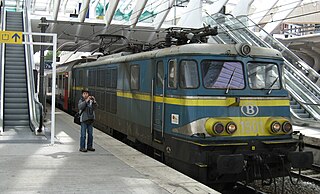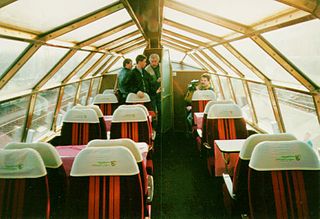Related Research Articles
The Aurora was a domestic Trans Europ Express in Italy linking Rome with Reggio di Calabria. The train was named after the Roman goddess of dawn, referring to the train's early morning departure from Rome.

The Brabant was an express train that linked Gare du Nord in Paris, France, with Brussels-South in Brussels, Belgium. The train was named after the historical Duchy of Brabant of which Brussels was the capital.
The Diamant was an express train operated by the Deutsche Bundesbahn (DB), using different routes over the years. The name Diamant, Dutch for diamond, refers to the city of Antwerp, which is the European centre of diamond trade and has a diamond district. The initial service started in 1962 as a first-class-only FernTriebwagen linking the West-German capital Bonn with Antwerp, using a class DB Class VT 08 diesel multiple unit (DMU).

The Ligure was an international express train operated by the Italian Railways linking Milan with the Côte d'Azur. The train was named after the Italian region Liguria which was served by the train.

The Île de France was an international express train on the PBA route (Paris–Brussels–Amsterdam). The train was named after the French region surrounding Paris.
The Lemano was an international express train linking Milan with Geneva. The train is named after Lake Geneva, the north shore of which was followed by the train over the lake's entire length. Introduced in 1958, it was a first-class-only Trans Europ Express service until 1982, and thereafter a two-class express train.

L'Oiseau Bleu was an international express train linking Antwerp with Paris. The train was named after the play L'Oiseau Bleu as a tribute to its author, the Belgian Nobel prize laureate Maurice Maeterlinck.

The Mont Cenis was an international express train linking Lyon in France with Milan in Italy. The train was named after the mountain range through which it crossed, inside the Fréjus Rail Tunnel on the French-Italian border.
The Memling was an express train that linked Gare du Nord in Paris, France, with Brussel Zuid in Brussels, Belgium. The train was named after German painter Hans Memling.

The Watteau was an express train that linked Gare du Nord in Paris, France, with Tourcoing in the North of France. The train was named after the French painter Antoine Watteau.
The Gayant was an express train that linked Gare du Nord in Paris, France, with Tourcoing in the department of Nord, also in France. The train was named after Gayant, the processional giant of Douai, France.
The Faidherbe was an express train that linked Gare du Nord in Paris, France, with Lille in the North of France. The train was named after the Lille born governor of Senegal, General Louis Faidherbe.

The Paris–Ruhr was an express train that linked Paris in France, with Dortmund in Germany. The train was named after its two termini, Paris in the west and the Ruhr district in the east. For most of its life, it was a Trans Europ Express (TEE).

The Rembrandt was an express train that linked Amsterdam in the Netherlands, with Munich in Germany and later Chur in Switzerland. The train was named after the renowned Dutch painter Rembrandt. For its first 16 years it was a first-class-only Trans Europ Express, becoming a two-class InterCity in 1983 and finally a EuroCity in 1987.

The Parsifal was an express train that linked Paris with Dortmund in Germany and later Cologne. The train was named after Wagner's opera inspired by the legendary knight Percival.

The Erasmus was an express train that linked The Hague, the Dutch seat of Government, with Munich in Germany. The train was named after the Dutch Renaissance humanist Desiderius Erasmus.
The Bacchus was an express train in Germany, initially linking Dortmund and Munich. The train was named after the Roman God of wine, although for most of its existence it linked two cities famous for producing beer.
The Heinrich Heine was an express train operated by Deutsche Bundesbahn, initially linking Frankfurt am Main and Dortmund. The train was named after the German poet and journalist Heinrich Heine.

The Molière was an international train operated by SNCF, initially linking Paris and Düsseldorf. The train was named after Jean Baptiste Poquelin using his stage name.

The Colosseum was an express train initially linking Rome and Milan, later Frankfurt am Main. The train was named after the Amphitheatrum Flavium, renowned as the Colosseum.
References
- ↑ La Légende des TEE p. 366.
- ↑ Das grosse TEE Buch p. 114
- ↑ La Légende des TEE p. 363.
- ↑ La Légende des TEE p. 367.
- ↑ La Légende des TEE p. 406.
- ↑ La Légende des TEE p. 407.
